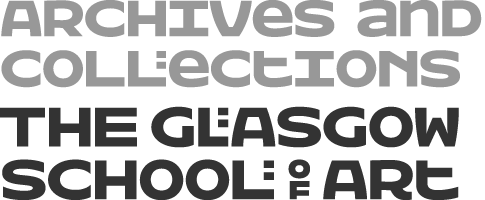Cicely Farrer was awarded a SGSAH-AHRC Collaborative Doctoral Award to undertake a PhD exploring Gender, Art and Activism at the Glasgow School of Art in 2024. The project is a collaboration between Glasgow School of Art Archives & Collections and the School of Art History at the University of St Andrews.. Six months into the three-and-a-half-year project, we ask Cicely to introduce her research –
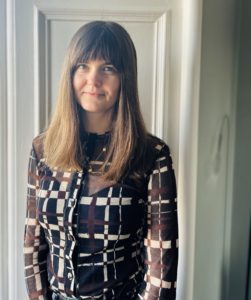
Can you tell us about your PhD research? What is it about?
My PhD project is looking at how artists at the Glasgow School of Art performed activism in their art and their lives. The question guiding my research is How have the women of Glasgow School of Art performed acts of resistance in response to an industrial military complex of the 20th and 21st century?
Performance is key to the project and refers to both live performances, in the theatrical or live art sense, and performative acts of resistance such as protests, prints, photos or banners. I am considering interactions between the institution and artists on issues like pay and employment rights, to be performances of the institution. The Collection also reflects the theatrical masques and tableaux vivants that the School presented frequently under Fra Newbery (1885 – 1917), imbuing performativity in the people and the place.
I am researching how women artists at the Glasgow School of Art are represented in the Archive through their actions and art works relating to peace, refugee or anti-war activism. I’d previously learnt about the feminist anti-nuclear performances of 1980s in Britain, particularly at Greenham Common Peace Camp, with playful performances like the “Teddy Bear’s Picnic” (1983) and the interventional “Die In’s” outside the Stock Exchange in the City of London (1982). Former GSA students Helen Biggar and Norman McLaren’s agitprop film Hell Unltd from 1936 is a good reminder, however, that so much of today’s peace and anti-military industrial activism started much earlier in the twentieth century. This infographic still from the film, showing the relationship of arms production to profit, could be something from Instagram in 2024.
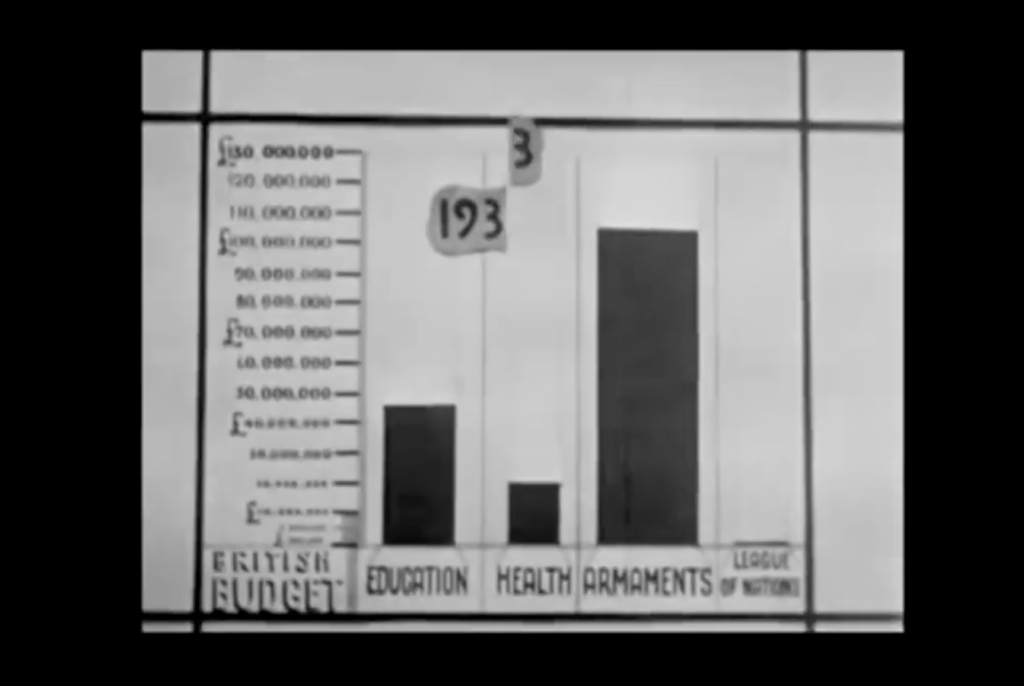
I quickly learnt that Glasgow Girl and educational reformer Ann Macbeth was a suffragette who created one of the most significant banners of the Women’s Social & Political Union, initially as a friendship quilt for the Suffragettes imprisoned for their militant acts of resistance in pursuit of women’s rights. The Holloway Prisoners banner, handstitched with the names of eighty imprisoned suffragette women, connects Macbeth and Glasgow School of Art to one of the senior leaders of the WSPU, Emmeline Pethick-Lawrence, who purchased the quilt at the WSPU Grand Bazaar at St Andrews Hall in Glasgow in 1910, and who later became a leading figure in the women’s international peace movement.
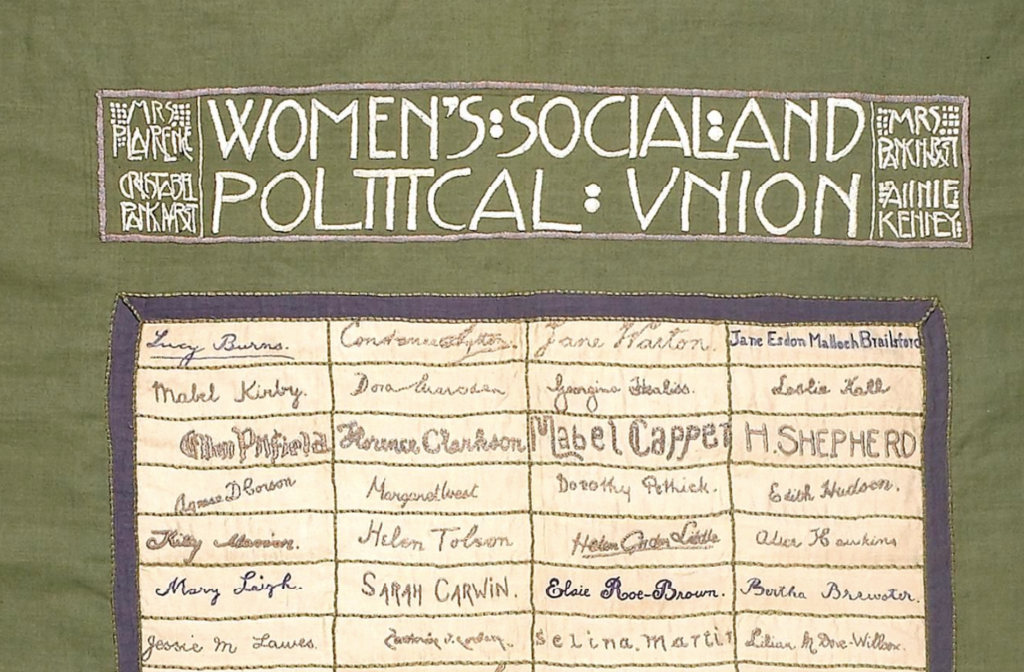
What is the scope of your research, and why is your research important?
I’m taking a trans-temporal approach, which means I’m looking at multiple time periods in the twentieth century. My methodology is ‘object-led’: art works, ephemera and materials are the starting point of the research. My PhD is also within the scope of ‘queer feminist art history’ which I interpret as taking a situated approach, positioning art, gender and activism within the social-political context from a queer feminist perspective, while retaining an honest and critical take on the imperialistic attitudes of the early twentieth century. Like many artists and curators, I’m trying to navigate what it means to work in the contemporary art and cultural sector during global conflict, increased militarisation and colonial wars.
I’ve started with the art and social history of the early 1900s, particularly around the suffrage movement and First World War, but I plan to look at artists throughout the century. It’s a big project!
Glasgow was one of the first art schools in the UK to admit women (as early as 1848), so perhaps it is unsurprising that suffrage was popular within the art school, with many of the women and men signed up to suffrage unions. The School was under the direction of artist Fra Newbery and during his tenure female student and staff numbers increased rapidly. A group of highly politicised women taught at the School in the early twentieth century, including celebrated artists and designers Dorothy Carleton Smyth, Jessie Rowat Newbery, Ann Macbeth, De Courcy Lewthwaite Dewar and Norah Neilson Gray. A former student of the early twentieth century, Jane Parkes, recalled stitching suffrage banners with Ann Macbeth in the embroidery studios between classes. [1]
Suffrage is a useful starting point, given the School’s relationship to the cause but also its wider influence on activism. For instance, the Suffrage movement has influenced performative and direct collective action for justice throughout the twentieth and twenty-first centuries, with examples including the actions of the LGBTQ+ rights group OutRage! [2]
Has anything surprised you so far in our collection? Any interesting finds?
I was excited to see a surprising piece of ephemera in an uncatalogued folder only a few weeks ago: a Performance programme…
In February 1909, Fra Newbery organised a Tableaux of three performances, “In Aid of the Bellfield Sanatorium Lanark”, in the Queens Rooms on Clifton Street in Glasgow. One of the Tableaux, titled “The (R)Evolution of Woman”, produced and directed by Dorothy Carleton Smyth, is a work of Suffrage activism. It was a comedy performed by staff and students of the School, including De Courcy Lewthwaite Dewar as “His Honour the Judge” (pictured), Helen Paxton Brown and James Maitland. I love Dewar’s charismatic stance here as she prepares to condemn the ‘guilty men’ to be specimens at the University of Glasgow Zoology Museum. I’m interested in the different gender roles people performed and the playful intervention with the more traditional masque productions that were usually quite nationalistic in style.
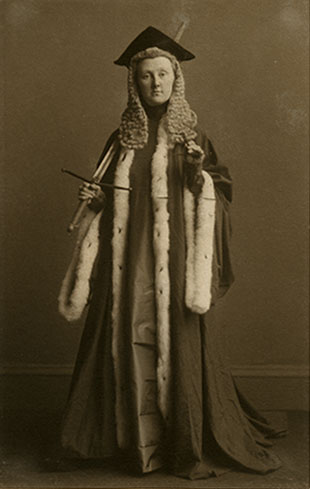
The Programme for the Tableaux Vivants is pictured below (page 1 and 4). The event was reviewed by
The Scotsman as well as the Airdrie & Coatbridge Advertiser which described the
“large and fashionable audience” who found “favour” with the “humorous touch” of this “topical” entertainment. [3]
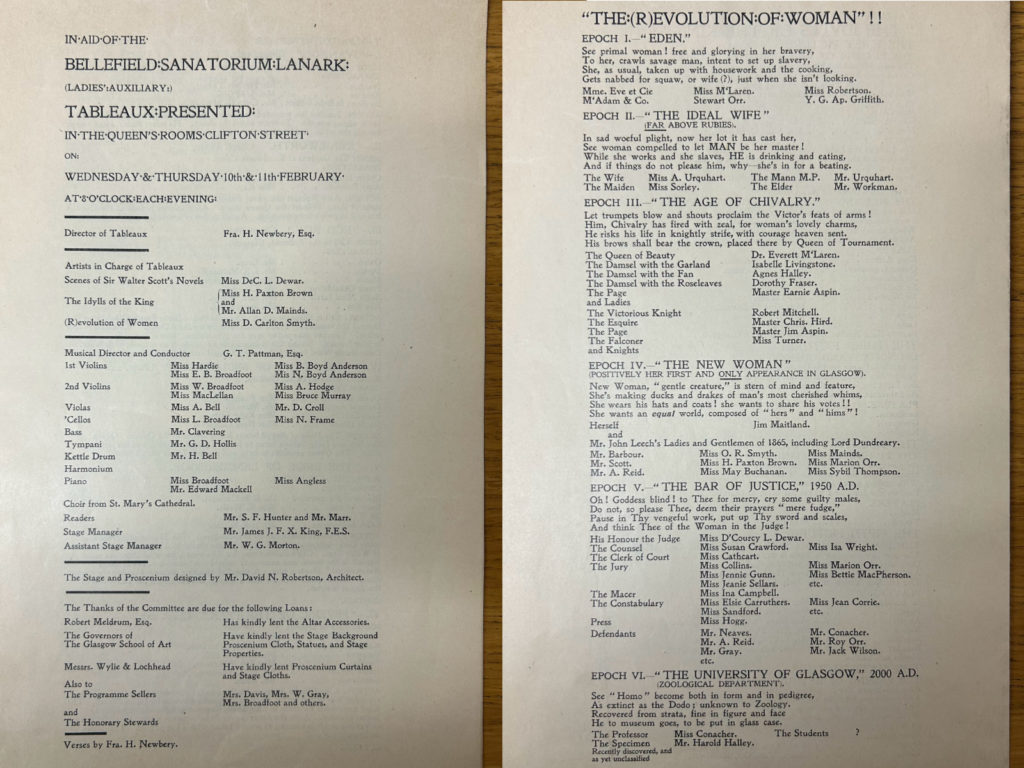
Dewar, Macbeth, Jessie Newbery and Carleton Smyth were all involved in suffrage events of the WSPU and the National Union of Women’s Suffrage Societies. Later iterations of this production were titled “The Evolution of Woman” at the First Scottish WSPU exhibition at St Andrews Hall (now the Mitchell Library) in 1910 and the “Devolution of Man” when performed at the Athenæum Hall in 1912 in an event organized by the non-militant group Glasgow & West of Scotland Association of Women’s Suffrage. [4]
The Programme for the Tableaux in Aid of the Bellefield Sanatorium of 1909 was not apparently a School production: There are no Glasgow School of Art logos, despite the typeface following their typographic ‘brand’. So while the staff and students were performing and the School was thanked, this was an independent production. Other GSA productions of the same period included the full ‘brand identity’ of the School. Did the Board of Governors feel they could not take ‘ownership’ of the event, given its suffrage undertones?

There is so much in the Collection that I am looking at and so I will save more for another time. As my research unfolds, I will share findings and stories with the online audience of the Glasgow School of Art Archives and Collections so you’ll be able to share your thoughts and reactions.
Biography: Cicely Farrer is a researcher and curator living in Dundee. She is in her first year of a SGSAH-AHRC collaborative doctoral award project on art, gender and activism, supervised by Glasgow School of Art Archives and Collections and the School of Art History at the University of St Andrews.
References:
[1] Elspeth King, The Scottish Women’s Suffrage Movement, 1978.
[2] Peter Tatchell of OutRage! Attributed the Suffragettes and the Situationists as influences on the OutRage! Group in the 80s during a talk at the Cooper Gallery DJCAD’s 12-Hour Acting Up event in February 2025. More info: https://www.dundee.ac.uk/events/ignorant-art-school-12-hour-acting
[3] Gathered through the British Newspaper Archive online in one of Dundee’s public libraries.
[4] Clare Thompson from the Special Collections at the Mitchell Library pointed me to this.
[5] Jude Burkhauser, Glasgow Girls: Women in Art and Design 1880-1920, 1988.

